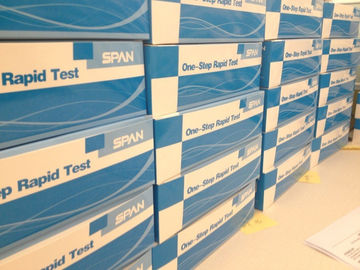|
|
Adenovirus Ag Rapid Test Cassette
|
Product Details:
Payment & Shipping Terms:
|
| Specificity: | 100% |
|---|
Specimens: Feces
For professional in vitro diagnostic use only
INTENDED USE
The Adenovirus Rapid Test Device (Feces) is a rapid visual immunoassay for the qualitative presumptive detection of adenovirus in human fecal specimens. This kit is intended to be used as an aid in the diagnosis of adenovirus infection.
INTRODUCTION
Acute diarrheal disease in young children is a major cause of morbidity worldwide and is a leading cause of mortality in developing countries. Research has shown that enteric adenoviruses, primarily Ad40 and Ad41, are a leading cause of diarrhea in many of these children, second only to the rotaviruses. These viral pathogens have been isolated throughout the world, and can cause diarrhea in children year round. Infections are most frequently seen in children less than two years of age, but have been found in patients of all ages. Further studies indicate that adenoviruses are associated with 4-15% of all hospitalized cases of viral gastroenteritis.
Rapid and accurate diagnosis of gastroenteritis due to adenovirus is helpful in establishing the etiology of gastroenteritis and related patient management. Other diagnostic techniques such as electron microscopy (EM) and nucleic acid hybridization are expensive and labor-intensive. With the self-limiting nature of adenovirus infection, such expensive and labor-intensive tests may not be necessary.
INTERPRETATION OF RESULTS
POSITIVE RESULT:
A colored band appears in the control band region (C) and another colored band appears in the A line region.
NEGATIVE RESULT:
One colored band appears in the control band region(C). No band appears in the test band region (T).
INVALID RESULT:
Control band fails to appear. Results from any test which has not produced a control band at the specified reading time must be discarded. Please review the procedure and repeat with a new test. If the problem persists, discontinue using the kit immediately and contact your local distributor.
NOTE:
1. The intensity of the color in test region (T) may vary depending on the concentration of aimed substances present in the specimen. Therefore, any shade of color in the test region should be considered positive. Besides, the substances level can not be determined by this qualitative test.
2. Insufficient specimen volume, incorrect operation procedure, or performing expired tests are the most likely reasons for control band failure.
PERFORMANCE CHARACTERISTICS
Table: Adenovirus Rapid Test vs. Latex Agglutination
Relative Sensitivity: >99.9% (95.6%-99.9%)*
Relative Specificity: 99.4% (96.5%-99.9%)*
Overall Agreement: 99.6% (97.7%-99.9%)*
*95% Confidence Interval
Specificity:
Cross reactivity with following organisms has been studied at 1.0 x 109 organisms/ml. The following organisms were found negative when tested with the Adenovirus Rapid Test Device (Feces).
Span Biotech Ltd.
Tel: +86(755)89589611
WhatsAPP:+8618823462100 (WhatsApp)
Web:www.spanbio.com www.spanbiotech.com
Contact Person: Ms. Anna Lee
Tel: +86-755-89589611
Fax: 86-755-89580096




